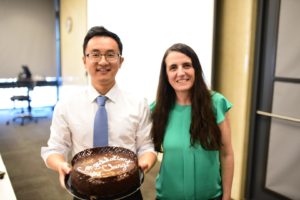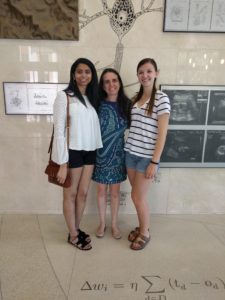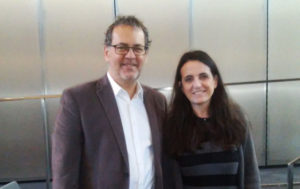Chengyi Tu defended his thesis titled “Role of Reactive Oxygen Species in Pluripotent Stem Cells Cardiac Differentiation and Survival”. Congratulations Dr. Tu, we look forward to seeing what you do next!

Engineering Stem Cell Microenvironments
Chengyi Tu defended his thesis titled “Role of Reactive Oxygen Species in Pluripotent Stem Cells Cardiac Differentiation and Survival”. Congratulations Dr. Tu, we look forward to seeing what you do next!

We congratulate our two seniors, Elissa Barone (right) and Meghana Koleti (left), who each worked for more than two years in the Zoldan Lab and were authors on two publications. We won’t forget their hard work, and wish them all the best in their future careers!

Alicia Allen successfully defended her thesis, “Anisotropy in Cell Sheeting and Cardiac Differentiation”, thereby completing her PhD requirements and becoming the first graduate of the Zoldan Lab. Congrats Dr. Allen, we look forward to following your future career!

At the Society for Biomaterials conference in Atlanta, GA, Dr. Zoldan gave a talk titled “Matrix Anisotropy in Cardiac Differentiation”. Cody Crosby also presented his poster “Characterizing the Effect of Cell-Matrix Interactions on the Vasculogenesis of iPSC-derived Vascular Progenitor Cells” in the evening presentations.
The Zoldan lab was excited to hear Professor Jeff Hubbell’s talk on engineering novel protein-based immunotherapies to treat Type I diabetes. Wishing him and his lab the best going forward.

Olivia Conroy, who is working with Chengyi Tu, proposed to elucidate the role of ROS in cardiomyocyte proliferation via MAPK signaling. Deepti Valliappan, working with Cody Crosby, aimed to evaluate vascular network formation of endothelial progenitor cells in gelatin-CMC hydrogels. Congratulations to both!
An exciting piece on Alicia’s work has been posted on the website of UT’s biomedical engineering website. If you’re interested, please give the article a read!
Dr. Zoldan was selected as a 2017 Biomaterials Science Emerging Investigator by the RSC journal “Biomaterials Science”. We are honored by the selection and extend our congratulations to the other honorees.
Chengyi recently published his paper “Glycogen synthase kinase-3 inhibition sensitizes human induced pluripotent stem cells to thiol-containing antioxidants induced apoptosis” in Stem Cell Research. The paper is linked here and the abstract can be found below:
Inhibition of glycogen synthase kinase 3 (GSK3) is an extensively used strategy to activate Wnt pathway for pluripotent stem cell (PSC) differentiation. However, the effects of such inhibition on PSCs, besides upregulating the Wnt pathway, have rarely been investigated despite that GSK3 is broadly involved in other cellular activities such as insulin signaling and cell growth/survival regulation. Here we describe a previously unknown synergistic effect between GSK3 inhibition (e.g., Chir99021 and LY2090314) and various normally non-toxic thiol-containing antioxidants (e.g., N-acetylcysteine, NAC) on the induction of apoptosis in human induced pluripotent stem cells (iPSCs). Neither Chir99021 nor the antioxidants individually induced significant apoptosis, whereas their combined treatment resulted in rapid and extensive apoptosis, with substantial caspase 3 activity observed within 3 h and over 90% decrease in cell viability after 24 h. We confirmed the generality of this phenomenon with multiple independent iPSCs lines, various thiol-based antioxidants and distinct GSK3 inhibitors. Mechanistically, we demonstrated that rapamycin treatment could substantially reduce cell death, suggesting the critical role of mammalian target of rapamycin (mTOR). Akt dysregulation was also found to partially contribute to cell apoptosis but was not the primary cause. Further, this coordinated proapoptotic effect was not detected in mouse ESCs but was present in another human cells line: a breast cancer cell line (MDA-MB-231).
Given the wide use of GSK3 inhibition in biomedical research: from iPSC differentiation to cancer intervention and the treatment of neuronal diseases, researchers can potentially take advantage of or avoid this synergistic effect for improved experimental or clinical outcome.
Alicia Allen has recently published in Biomaterials Science on generating anisotropic cell sheets from electrospun fibers. The fibers are a blend of two polymers, one that is cell adhesive (PCL) and one that is thermosensitive (PNIPAAm). When PNIPAAm undergoes a temperature induced phase transition, the cells detach; therefore, this method is both inexpensive and enzyme-free. The abstract can be found below:
Cell alignment in muscle, nervous tissue, and cartilage is requisite for proper tissue function; however, cell sheeting techniques using the thermosensitive polymer poly(N-isopropyl acrylamide) (PNIPAAm) can only produce anisotropic cell sheets with delicate and resource-intensive modifications. We hypothesized that electrospinning, a relatively simple and inexpensive technique to generate aligned polymer fibers, could be used to fabricate anisotropic PNIPAAm and poly(caprolactone) (PCL) blended surfaces that both support cell viability and permit cell sheet detachment via PNIPAAm dissolution. Aligned electrospun PNIPAAm/PCL fibers (0%, 25%, 50%, 75%, 90%, and 100% PNIPAAm) were electrospun and characterized. Fibers ranged in diameter from 1–3 μm, and all fibers had an orientation index greater than 0.65. Fourier transform infrared spectroscopy was used to confirm the relative content of PNIPAAm and PCL. For advancing water contact angle and mass loss studies, only high PNIPAAm-content fibers (75% and greater) exhibited, temperature-dependent properties like 100% PNIPAAm fibers, whereas 25% and 50% PNIPAAm fibers behaved similarly to PCL-only fibers. 3T3 fibroblasts seeded on all PNIPAAm/PCL fibers had high cell viability and spreading except for the 100% PNIPAAm fibers. Cell sheet detachment by incubation with cold medium was successful only for 90% PNIPAAm fibers, which had a sufficient amount of PCL to allow cell attachment and spreading but not enough to prevent detachment upon PNIPAAm dissolution. This study demonstrates the feasibility of using anisotropic electrospun PNIPAAm/PCL fibers to generate aligned cell sheets that can potentially better recapitulate anisotropic architecture to achieve proper tissue function.
© 2025 Zoldan Lab
Theme by Anders Noren — Up ↑